- Joined
- Aug 10, 2018
- Messages
- 2,039
- Reaction score
- 3,331
@stripperguy, I am very pleased with it so far and I am happy that all the lurking / reading build threads seems to be paying off. I'll get it wet (and, from what I understand, give it a pretty good beating) at the end of the month. Hoping to get a day trip or two in first to make sure I don't swim more than paddle but we'll see. Worst case, it goes, untested, on a 120 mile(ish) paddle.

I took a picture of the bow bulkhead tonight. I could probably get the bottom tighter (and I would if I were making it to sell) but it'll do...
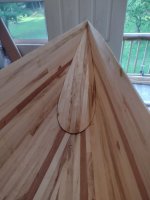
While I was there, I also removed the seat strips from the forms, buttered both sides of the strips pretty liberally with epoxy and re-clamped them in the forms. There are 4 Cherry strips and 3 White Oak per cross rail. (probably overkill but I am more likely to gain weight than lose it at my age so...)
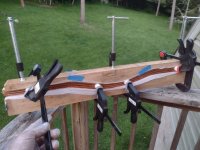
The white on the bar clamps are 1 inch pvc cut about an inch long and then filed smooth so the epoxy can't (hopefully) get hold of them. They seemed to do well aligning the strips and I tightened the c-clamps most of the way, squeezed the pvc / bar clamp combo to align the strips and then finished cranking down the c-clamps.
Oh... I didn't have clear packaging tape over there yet and I have a (what may be a lifelong) distrust of blue "clean release" tape so I used wax paper on the forms. I'm hopeful but I also realize that I can burn all of it if it's a disaster.
Hoping to enlist the help of my friend with the sawmill (he IS a woodworker) to help finish the seat and figure out a way to do the inwales / thwarts as I'd like them. Planning a marathon, epoxy the inside and install all trim (except, possibly the seat) this weekend or next.
Certainly starting to look like I'll get to scratch her up the last week of August.
Jim, I glassed the backside of the bulkhead panels previously and put a bit of a bevel on where needed to get a decent fit. As usual, you've outdone yourself with fit & finish and I may get there eventually. I went for "close enough" and I'm pleased. Kinda wish I'd paid more attention to the centerline of the bulkhead & the placement of the Cherry strip but... Wait... I'm starting to care way too much what this looks like!Put a sharp bevel on the bottom edge, to make it easy to glass, and blend with the hull.
Glass both sides of the insert also !
I took a picture of the bow bulkhead tonight. I could probably get the bottom tighter (and I would if I were making it to sell) but it'll do...

While I was there, I also removed the seat strips from the forms, buttered both sides of the strips pretty liberally with epoxy and re-clamped them in the forms. There are 4 Cherry strips and 3 White Oak per cross rail. (probably overkill but I am more likely to gain weight than lose it at my age so...)

The white on the bar clamps are 1 inch pvc cut about an inch long and then filed smooth so the epoxy can't (hopefully) get hold of them. They seemed to do well aligning the strips and I tightened the c-clamps most of the way, squeezed the pvc / bar clamp combo to align the strips and then finished cranking down the c-clamps.
Oh... I didn't have clear packaging tape over there yet and I have a (what may be a lifelong) distrust of blue "clean release" tape so I used wax paper on the forms. I'm hopeful but I also realize that I can burn all of it if it's a disaster.
Hoping to enlist the help of my friend with the sawmill (he IS a woodworker) to help finish the seat and figure out a way to do the inwales / thwarts as I'd like them. Planning a marathon, epoxy the inside and install all trim (except, possibly the seat) this weekend or next.
Certainly starting to look like I'll get to scratch her up the last week of August.

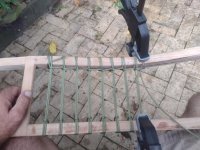
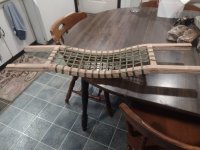
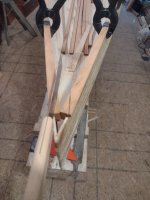
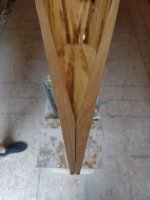
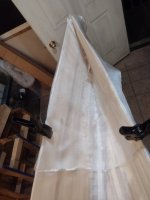
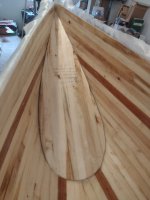
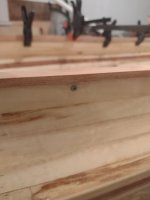
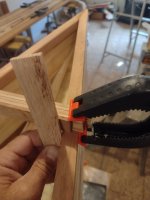
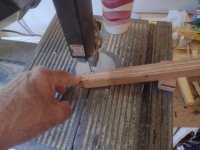
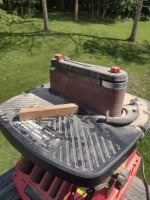
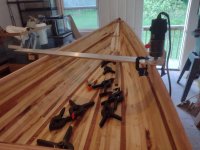
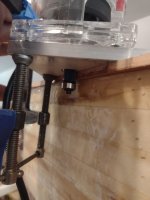
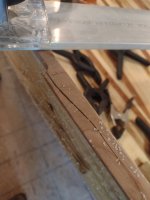
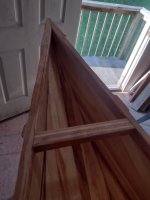
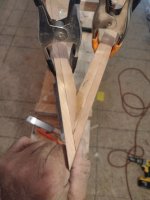
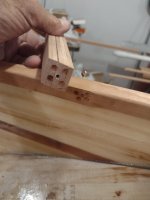
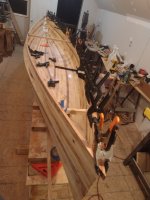
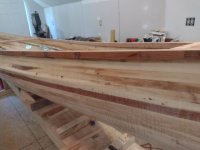
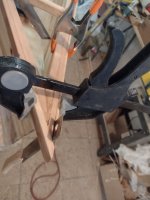
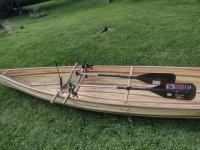
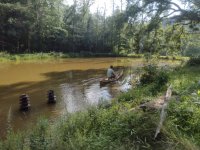
![DSCN1397[1].JPG DSCN1397[1].JPG](https://www.canoetripping.net/data/attachments/27/27471-d4507837110d2aef6e4b1a6c58762300.jpg?hash=1FB4NxENKu)
![DSCN1398[1].JPG DSCN1398[1].JPG](https://www.canoetripping.net/data/attachments/27/27472-cb00106dbee82d87e658214a06e622db.jpg?hash=ywAQbb7oLY)
![DSCN1400[1].JPG DSCN1400[1].JPG](https://www.canoetripping.net/data/attachments/27/27474-99bd0405c745a20974cb8f693388685d.jpg?hash=mb0EBcdFog)
![DSCN1402[1].JPG DSCN1402[1].JPG](https://www.canoetripping.net/data/attachments/27/27475-52c522e662b2ce3347985816267491b5.jpg?hash=UsUi5mKyzj)
![DSCN1406[1].JPG DSCN1406[1].JPG](https://www.canoetripping.net/data/attachments/27/27494-3c250a928843ccbe1136284ac69b7577.jpg?hash=PCUKkohDzL)
![DSCN1411[1].JPG DSCN1411[1].JPG](https://www.canoetripping.net/data/attachments/27/27495-1bbea6e73a8f3d3756160efed9cdad7b.jpg?hash=G76m5zqPPT)
![DSCN1408[1].JPG DSCN1408[1].JPG](https://www.canoetripping.net/data/attachments/27/27496-f8f70046e37752842f46d407c3c7fd3f.jpg?hash=-PcARuN3Uo)
![DSCN1410[1].JPG DSCN1410[1].JPG](https://www.canoetripping.net/data/attachments/27/27497-6a304798d225036d3a7de7921b0def4d.jpg?hash=ajBHmNIlA2)